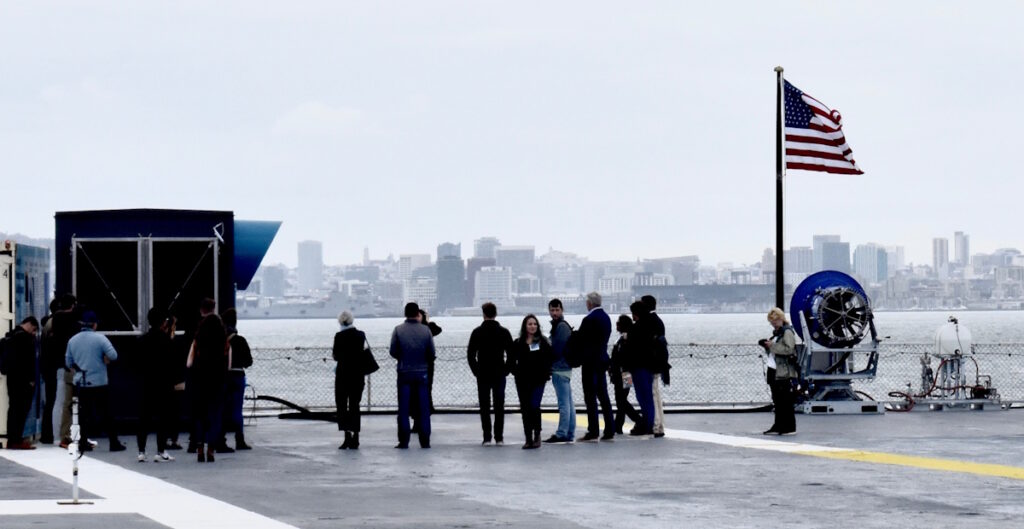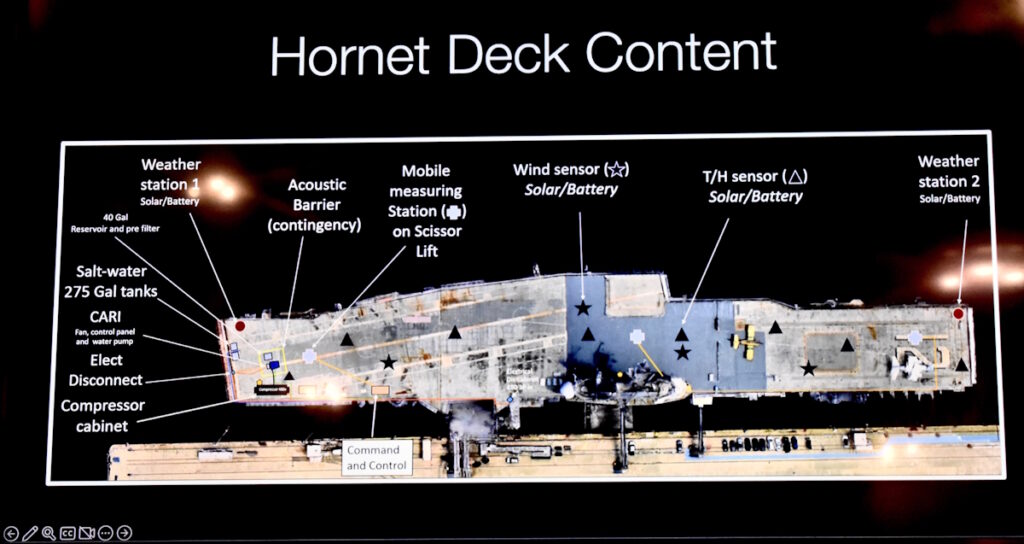Project On Indefinite Hold Pending City Analysis Of Experiment And Future Council Decision

By Larry Freeman
The little experiment that could one day help lead to global climate cooling mitigations recently became a major science story buzz in the likes of The New York Times, local TV, radio, The SF Chronicle and even Popular Mechanics and The Smithsonian Magazine to name a few.
But now the Marine Cloud Brightening Program (MCB) headed up by leading climate scientists at The University Of Washington who chose Alameda’s USS Hornet Museum for their laboratory, his hit major headwinds as the City Of Alameda has, at least for now, shut down the first of its kind in The U.S. experiment.
MCB seeks to determine if adding microscopic particles of pure sea salt with fresh water to create a vaporous plume that could enhance the ability of clouds to act as giant sun reflecting umbrellas of sorts. The theory involves how cloud reflectivity of warming sunlight upwardly might help cool ocean waters below in “hot spots” around the planet highly impacted by ocean warming from climate change.
(for the whole story on the project please click here:
https://alamedaneighborhoodsnews.org/alameda-home-to-cutting-edge-climate-cooling-experiment/ )
The MCB project began with great accolades and fanfare and looked to have nothing but blue skies ahead to conduct its small scale study that has been determined to pose no environmental danger by an independent climate research group, Farallon Strategies (FS).
UW hired FS in advance of deployment of the experiment to The Hornet to examine environmental impacts and potential compliance and permitting matters with Federal, State and local entities.
The USS Hornet Museum gratefully agreed to become home base for the MCB group seeing an opportunity expand their educational mission, gain needed “event space” revenues to help keep them afloat., and, if the experiment works, take a step towards possibly mitigating ocean warming someday in the future.
The UW MCB team ran a few days of experiments, hailed as initial successes, beginning April 2nd of this year but the project went dark about two weeks later when The City Of Alameda was beset with concerns about possible negative environmental impacts by residents and at least one City Council member, Trish Spencer.
City manager Jennifer Ott, on April 16th, sent Hornet Executive Director (now CEO) Laure Fies, what, in effect, amounted to a cease and desist letter along with a host of inquiries as to just what was going on with the MCB program and what was happening or might happen to the surrounding environment.
The letter’s first line noted “recent conversations related to the significant concerns raised by The Alameda City Council and public regarding the recent testing of experimental equipment onboard the USS Hornet’s flight deck.”
The letter called for “chemical specifications of the salts” and any other chemicals being aerosolized, permits obtained, applied for or denied, duration and frequency of the experiments, the educational component of the testing and a few other particulars.

The exact nature and timing of those conversations remains to be established, as does whether or not The City had been made privy to FS research by either The Hornet or UW MCB prior to its April 16th letter.
However, a March 20th letter from The Hornet addressed “To Whom It May Concern” and presumably sent to the City, suggests that some kind of heads up about the MCB Program was provided them. ANN is awaiting a response from The Hornet and The City regarding that aspect.
Farrallon Stratagies, UW MCB Project And The Hornet Found No Environmental Or Permitting Issues. City Is Not On Board, At Least For Now
FS gave UW a green light to proceed based on its analysis, and interviews with both Hornet and MCB persons suggest that they relied on those findings to go ahead with things as the ‘weather window’ needed to have the right conditions was opening in the spring.
When it came to FS’s findings on the large scale issues related to the legality and impacts of the experiment, there seemed to be no problem. That conclusion was echoed in the point by point response to Ott’s nine inquiries in the 4/16 letter.
FS indicated that USS Hornet considers the proposed small scale study …“to be included within their existing within their existing permitted operational characteristics.”

The FS study examined MCB Program compliance with respect to standards and protocols of The EPA, NOAA, The California Air Resources Board, The SF Bay Area Air Quality Management District, The SF Bay Conservation and Development Commission, The California Governor’s Office of Planning and Research, The White House Council on Environmental Quality, and The International Maritime Organization and determined that all was in good order with respect to the Program’s environmental impacts.
Depending on the above agencies’ purview, the FS study noted, for example, that “no permit is required” when it comes to EPA thresholds on atmospheric saline droplet emissions from MCB due to amounts falling under the 100 tons per year mark.
It found no problems with requirements under The Clean Water Act, no water pollution impacts, no problems with California or National Environmental Quality Acts provisions, and so on.
With respect to “known or potential environmental impacts of the study” the FS report said that “ the generated plume is of sea salt droplets” and the location of the study posed no issue.
In one case, with respect to atmospheric impact notifications and requirements by NOAA, the FS study noted that a small, localized experiment as the one at hand requires no reporting as long as they can “reasonably be respected not to modify the weather outside of the area of operation.”
This project, according to an earlier interview with Co Lead Researcher Dr Sarah Doherty does not even impact the local weather beyond the deck of The Hornet.
The FS analysis also notes that the MCB study’s emissions fall “below the threshold for required permits from the EPA.”
THE MAJOR BONE OF CONTENTION IS WHETHER OR NOT THE HORNET’S LEASE AGREEMENT PERMITS THE MCB EXPERIMENT; THE SAME ISSUE SEEN THROUGH DIFFERENT LENSES
However, when it came to The FS review of The City and County of Alameda its summation that “The Study is covered under the USS Hornet’s existing permits” has become a bone of contention with The City Manager’s Office headed by Jennifer Ott.
Ott wrote, in the letter to The USS Hornet Museum that “this activity is inconsistent with the allowed museum use” as defined by the organization’s Lease Agreement with the City, which is essentially its landlord due to the location of the ship’s berthing on City owned property.
That interpretation stands in stark contrast to Fies’ March 20th statement reading that” nothing within this project exceeds a scale or use of machinery, power, or materials beyond the Museum’s usual restoration and operational use that goes beyond the scope of our Use Permit.”
WILL THE MCB PROGRAM RESUME OR IS IT DEAD IN THE WATER? — THAT IS THE QUESTION
The Ott letter said, in another aspect of the situation to order a cessation of the project that “prior consent from the City has not yet been sought or granted,” which has contributed to the ongoing halt to the project “until the City has given written authorization.”
Such a move, if it happens at all, will likely not be coming until the City Council holds a public hearing and deliberates on the matter.
Ott said, in an email interview, any such decision might not take place until sometime in June as the city is “in regular contact with the Hornet and the researchers and are actively evaluating a significant amount of information from them.”
The ongoing contact, as it is termed, may need to venture into uncharted waters as, according to FS, “ few agencies have specific language related to permitting requirements for small scale atmospheric sea salt process studies (as they ) fall below certain regulatory thresholds and produce an aerosol of a scale that will not measurably alter local or regional weather or climate.”
That adds another ‘cutting edge’ unknown to the mix, that goes beyond the elemental experiment itself and the as yet undetermined results it may yield.
The FS report adds that “research teams seeking to do more studies” should work with various agencies to “co-develop more specific permitting language as atmospheric sea salt process studies potentially grow in scale and geographic extent.”
In the near term, the question remains as to whether or not The City will take the perspective that Fies closes with at the end of her response letter to the city and see the forest for the trees. “We know how seriously the City Of Alameda views climate change and look forward to you being a leading partner in this study which will contribute to the tools we will need to fight the disastrous effects of climate change in the future.”
MDB Program Co-Lead, Dr. Sarah Doherty, also maintains a view towards a positive outcome as matters move along the communication process. “The CAARE effort was designed to engage local stakeholders in areas where things are new, and these discussions are evolving positively and not in a way that is unexpected,” she said in an email.

